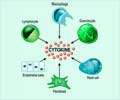Scientists have charted the structure and actions of a powerful substance that enables poxviruses to evade the immune system.
Scientists have charted the structure and actions of a powerful substance that enables poxviruses to evade the immune system.
Experts from Saint Louis University and the University of Alabama at Birmingham attribute their achievement to the study of a powerful protein found in the mousepox virus—one of the family of viruses that also includes smallpox, monkeypox and cowpox.This protein binds to a substance called interferon-gamma, which is produced by the immune system as the virus enters the bloodstream. This way, the protein immobilizes the interferon-gamma, preventing it from marshalling the immune system’s defences.
All this facilitates the replication of the poxvirus, which then causes immense damage.
“Cracking open and describing the structure and actions of interferon-gamma binding protein is incredibly exciting, given the important role this substance plays in subverting the immune system,” said Mark Buller, professor of microbiology and immunology at the Saint Louis University School of Medicine.
“This breakthrough is something that many others have tried and failed to achieve,” he added.
The researchers say that the findings have great potential for use in developing drugs that target immunological and inflammatory disorders, including a type of heart disease called atherosclerosis (sometimes referred to as hardening of the arteries), inflammatory bowel diseases (such as Crohn’s disease and ulcerative colitis) and rheumatoid arthritis.
Advertisement
Of all the poxviruses, smallpox in particular has played a gruesome role in human history. Though it was declared officially eradicated in 1979, many experts fear that clandestine samples of the virus may have survived.
Advertisement
Buller also commended Tony Nuara, a fourth-year student at Saint Louis University School of Medicine who was working on his Ph.D. in molecular microbiology when taking part in the research effort, for his contributions.
“Without Tony, this research wouldn’t have happened. He solved huge numbers of problems and figured out some answers to puzzling questions that previously had no answer,” Buller said.
The research is soon to be published in an early online edition of the Proceedings of the National Academy of Sciences.
Source-ANI
SRM/L







